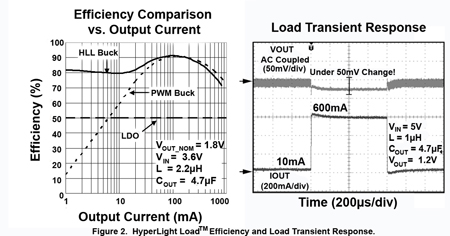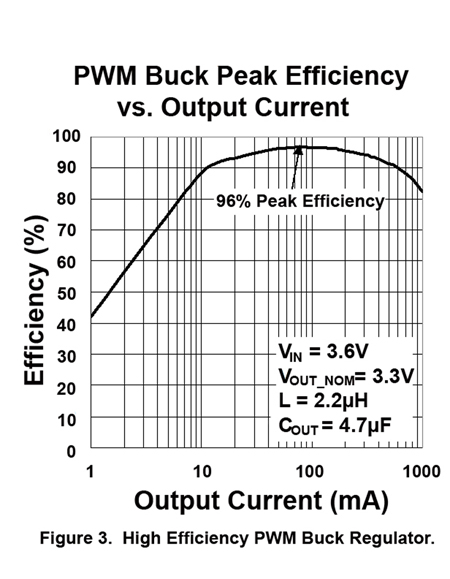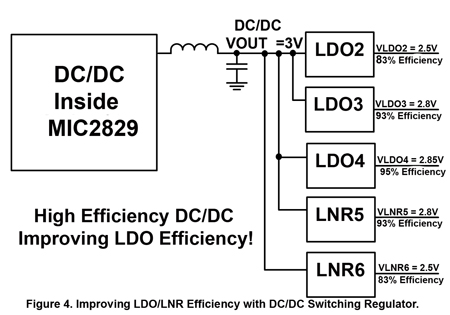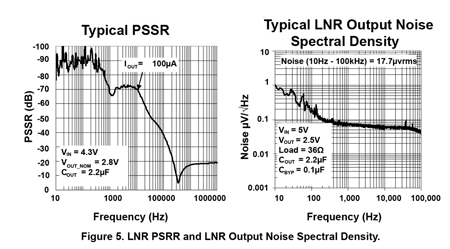Author:
Brian Huang, Applications Engineer, Micrel Inc., San Jose, California
Date
09/28/2010
In the next few years, the term "3G" will become the substandard mobile broadband connection as "4G" debuts across major US cellular network carriers. At a nominal data transfer rate of 100Mb/s, 4G will supersede the current 14Mb/s 3G standard and grant mobile devices online freedom at speeds comparable to broadband speeds at home or at work. No doubt, this upcoming transition will require sophisticated circuitry and even more sophisticated power management. Micrel's MIC2829 is a highly integrated Power Management Integrated Circuit (PMIC) designed to revolutionize the powering of 3G/4G platforms in the mobile broadband market. The device incorporates four HyperLight LoadTM (HLL) DC/DC buck regulators, two 100 percent duty cycle PWM buck regulators, five general purpose LDOs, six high performance Low Noise Regulators (LNR) and digital level shifters for SIM Card support. The MIC2829 also features synchronized startup, fixed and adjustable output voltages, voltage scaling, external soft start delay and power on reset (POR). This high level of integration combines seventeen regulators and their features into an 85-bump 5.5mm x 5.5mm FBGA package or a 76-pin 5.5mm x 5.5mm LGA package with a junction temperature range from -40°C to +125°C. The MIC2829 represents the future of high performance design in mobile platforms because it integrates both the benefits of switching regulators and LDOs by providing high efficiency, improving performance and reducing solution size. The single-chip complete solution reduces valuable board space lost in the packaging when using multiple chip solutions and shrinks the total solution size below 250mm2. This enables the IC to easily fit onto portable USB dongles in 3G/4G wireless modems. The space saving leads to cost saving and is just the beginning. The technologies incorporated into the MIC2829 make it an elegant, high performance PMIC that delivers the best power management solution in mobile platforms.
HyperLight LoadTM buck regulators Micrel's HyperLight LoadTM buck regulators are some of the most advanced switching regulators on the market today. The "Hyper" refers to the ultra-fast load transient response of the HLL regulator. The "Light Load" refers to the high efficiency at light loads. Unlike traditional PWM buck regulators, the HLL buck regulator will automatically adjust its switching scheme from light load to heavy load in order to maintain high efficiency across the entire load range. At light loads, the HLL regulator will switch at a lower frequency to reduce switching losses. As the load increases, the switching frequency increases until the device goes into continuous conduction mode (CCM). Once in CCM, the HLL regulator will switch at a constant frequency to maintain high efficiency. The four HLL buck regulators on the MIC2829 (DC1 to DC4) are designed with all the benefits of HLL regulators including the low quiescent current and the easiness of input and output decoupling using tiny ceramic capacitors. The low quiescent current consumption reduces current draw during the sleep-mode (light load) operation. When full operation (heavy load) is required, the HLL buck regulators will continue to provide high efficiency to maximize battery life. The HLL regulators (DC1, DC2 and DC4) on the MIC2829 all have a 4MHz switching frequency in CCM. The high switching frequency allows for use with lower inductance, which generally translates to smaller sized inductors. The HLL regulator (DC3) is set at a higher output voltage and is specifically designed to switch at 2.5MHz in CCM to accommodate for the higher duty cycle. The output current capability of the HLL buck regulators on the MIC2829 is designed to meet the power requirements inside 3G/4G modems (DC1-1A, DC2-300mA, DC3-600mA and DC4-600mA). DC1, DC2 and DC4 can be used to provide power to the CPU Core, the digital input/output interfaces and the memory inside 3G/4G modem designs. The DC3 HLL regulator can be used to provide input power to the LDOs on the MIC2829 to improve the LDO efficiency. For example, since the efficiency of an LDO is approximately the output voltage divided by the input voltage, by setting DC3's output voltage slightly higher than the dropout voltage of the LDOs, the efficiency of the LDOs will be higher due to the low voltage drop. Driving the LDOs with the HLL buck regulator is a key advantage of the MIC2829 that helps maintain high efficiency throughout the entire system without sacrificing performance or solution size.

High efficiency PWM buck regulators When integrating different types of voltage regulators into a single PMIC, it is advantageous to select the right type of regulator for the right application. There are two high efficiency, 100 percent duty cycle, 2MHz PWM buck regulators on the MIC2829 (DC5 and DC6). The advantage of using standard PWM regulators on the MIC2829 lies in their high efficiency in CCM, excellent output voltage accuracy and high duty cycle capability. Since the PWM regulator can maintain over 96 percent efficiency in CCM, it is ideal for powering RF transceivers and power amplifiers for the mobile RF antenna. If required, DC5 and DC6 can also be set at a slightly higher voltage to drive LDOs to improve LDO efficiency. The two PWM buck regulators on the MIC2829 are adjustable, using external resistors to support various voltage levels, and each has an 800mA output current capability for various application requirements. Since DC5 and DC6 are best used in CCM to benefit from the high efficiency, they are best paired with higher current power blocks which use higher currents for majority of the time. Using the PWM regulator under the best conditions will help benefit the overall system design by providing the highest possible efficiency given the space allowed.

General purpose LDOs There are five general purpose 200mA LDOs; (LDO1-LDO4, LDO11) on the MIC2829. They are ideal for powering various baseband circuitries such as digital signal processors (DSP), various input/output (I/O) interfaces, phase lock loops (PLL), analog-to-digital (ADC) converters and pulse amplitude modulation (PAM) control power. The general purpose LDOs on Micrel's MIC2829 have all the advantages of LDOs such as low dropout, good input noise rejection and low ground current. One disadvantage of using LDOs is their low efficiency when the difference between the input voltage and the output voltage is large. On the MIC2829, the general purpose LDOs do not have to worry about this disadvantage since the high voltage drop from the main system power rail is managed by a switching regulator. The LDOs on the MIC2829 can be driven by a switching regulator with output voltage set slightly above the dropout voltage of the LDOs that it is driving. This guarantees that the LDOs will be operating with maximum efficiency. Since the switching regulator has high efficiency, driving the LDOs with it reduces the total system power loss. This translates into longer battery life without sacrificing performance or solution size; one of the advantages of using such a highly integrated PMIC.

High performance low noise regulators (LNRs) The remaining six high-performance 200mA LNRs (LNR5-LNR10) on the MIC2829 are designed specifically to meet the requirements of noise sensitive RF circuitry inside 3G/4G applications. Each LNR has low dropout and ultra-low noise (20μVrms), maintains high PSRR (70dB at 1kHz) and requires just 20μA of quiescent current to operate. To improve efficiency, the LNRs can also be driven by a high efficiency switching regulator on the MIC2829. This helps keep the LTE/HEDGE RF circuitry inside 3G/4G applications running at maximum efficiency without sacrificing performance. The integration of LNRs in the MIC2829 covers the need for higher performance LDOs in RF circuitry without having to drive the RF section separately with other devices and waste space.

Digital level shifters for SIM card The MIC2829 has built in SIM Card Level Translation. There is a tiny LDO capable of 50mA in the SIM Card interface designated for powering the level shifters. There are three digital level shifters that facilitate the communications between the RF, the baseband and the SIM card. The digital level shifters can shift the voltage from the baseband (1.8V) to the SIM Card (1.8V or 3.0V). The shifted voltage can be set to high or low using the Voltage Select Level Shifter (VSLS) pin. The integrated SIM Card level translation eliminates the need for another device to do the interfacing and simplifies the final design. The MIC2829 PMIC advantage During the wireless 3G/4G development stage, there are many solutions to choose from. Simply cutting and pasting multiple power management circuits together could work, but might not be the best solution possible and does not present an ingenious engineering design that creates change. A revolutionary technology such as 4G, is an engineering marvel that will transform how people experience the Internet and as such, deserves a meticulously engineered power management solution to support it. The MIC2829 integrates Micrel's latest technology into a single-chip PMIC to deliver a complete solution for the next generation 3G/4G LTE/HEDGE applications. The fast, powerful and highly efficient HyperLight LoadTM regulators, the high efficiency, 100 percent duty cycle PWM regulators, the low dropout general purpose LDOs and the high performance LNRs have been available for system designers to use in their portable applications for years. These are all proven technologies that are currently being used globally. Inside the MIC2829 are carefully designed, enhanced and combined technologies ready to provide system designers who are working on 3G/4G applications a complete, single-chip solution that will reduce cost, provide high efficiency, improve performance and save valuable board space. This is the beginning of a highly integrated power management revolution that is going to create products that leap forward and raise the wireless bar. www.micrel.com